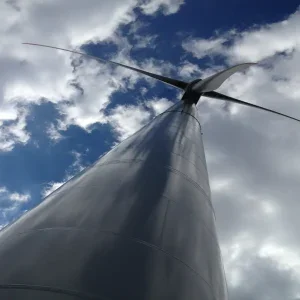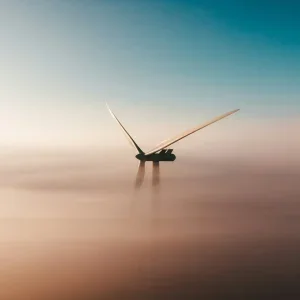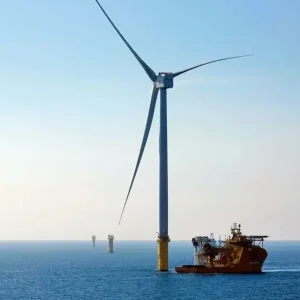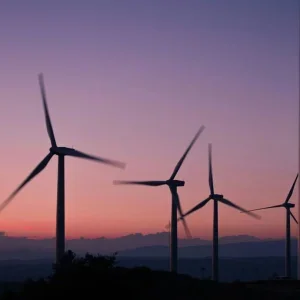Gravity and suction bucket foundations are two technologies that promise a number of advantages − including the potential to reduce the cost of offshore wind projects − over the ubiquitous monopile for seabedmounted installations.
At Vattenfall’s European Offshore Wind Deployment Centre off Aberdeen Bay, Scotland, what have been described as ‘game-changing’ suction bucket jackets are to be used to provide the foundations for eleven large MHI Vestas V164-8.4 turbines (to be connected using ‘next-generation’ 66kV array cabling, instead of 33kV).
The suction buckets to be demonstrated at the European Offshore Wind Deployment Centre (EOWDC) are expected to enable faster offshore installation, while also keeping noise to a minimum and facilitating decommissioning. Peterhead Port Authority has recently been awarded a contract to harbour the suction bucket jacket foundations for the 11-turbine scheme.
This contract will see the port moor one of the world’s largest floating cranes with a maximum lifting capacity of 5,000t, and up to six barges that will transport the 11 foundations, the heaviest of which weighs around 1,800t and is about 77m high. Peterhead Port Authority
will also accommodate two supporting offshore construction vessels and a project site office will be established at the harbour for the EOWDC installation operations, which are due to start later this year.
The Peterhead Port Authority contract, including the foundations and cabling, was awarded by Boskalis, Vattenfall’s key supplier for offshore construction and installation.
“Peterhead has been an integral part of the UK’s energy industry for the past 50 years”, said Ian Laidlaw, chief executive of Peterhead Port Authority, and “the EOWDC represents a new chapter”.
Peterhead Port becomes the latest harbour in the north-east of Scotland to provide key support for the EOWDC. Last year, Vattenfall invested in leases totalling 24 years with Aberdeen Harbour Board to establish a base at Regent Centre for its construction team and a warehouse unit at Commercial Quay to support the lifetime operations of the project.
“Peterhead Port Authority’s facilities provide a natural fit to support the foundation installation work for a number of reasons,” Andre Andringa, project director at Boskalis says. “With more than 3km of deepwater berthing, it can comfortably accommodate a large heavy-lift vessel, while the harbour is also sheltered, which helps minimise the impact of weather conditions for loading.”
The foundations will be transported to Peterhead for mooring via the six barge vessels, five of which will carry two foundations, while the sixth will transport the final one. The installation vessel will be moored alongside the barges for heavy-lift operations. When offshore work starts, more than half the foundations will be installed under the water within the seabed.
Gravity foundations without cranes
Development of ‘float and submerge’ gravity foundations is another area attracting interest. A pioneer in this field is Seatower, which is working on gravity foundations for offshore wind turbines and substations that can be installed without cranes, and was recently named winner of the 2017 Eurelectric Industry and Innovation Award. This was in recognition of its “unique technology”, which is said to represent “a breakthrough in the offshore industry, because of a less risky process – as the installation involves fewer personnel in offshore operations – faster and much simpler installation procedure and larger weather conditions window”.
The first Seatower Cranefree Gravity foundation for offshore wind was installed in February 2015 at EDF’s Fécamp offshore wind farm site about 15km off the French coast at a water depth of 30m.
Receiving the Eurelectric award, Seatower CEO Petter Karal said the foundation design was “perfect for larger turbines”, with installation able to take place during winter time in harsh offshore conditions, “which is one of several advantages that reduce the total cost of an installed gravitybased foundation compared with the commonly used steel structures.”
The Seatower foundation is said to “represent a rethinking of the entire value chain, from lean manufacturing methods to safe and cost-efficient installation.”
The hollow foundations are “selffloating” before installation on the seabed, which is achieved by filling them with seawater. Only towing vessels are required for the transportation and installation of these foundations, which have also been described as “self-installing.”
The foundations have been designed to employ mass manufacturing methods “using only standard, low-cost materials including regular concrete and steel.”
There is no noise from pile hammering or drilling during the installation process, and at end-of-life, no steel or concrete is left on the seabed following decommissioning.
Another type of float and submerge gravity foundation, designed and manufactured by Royal BAM Group, is to be deployed at EDF’s five-turbine 41.5MW Blyth Offshore Demonstrator wind farm in the UK. As reported in a previous issue of World Wind Technology, two of the five Blyth gravity foundations will be fitted with sensor system designed by the Offshore Renewable Energy (ORE) Catapult to analyse their performance, as part of the Demowind-funded FS Found project.
Each of the Blyth gravity-based foundations will weigh more than 15,000t when fully installed. Blyth will also employ 66kV array cables, the first offshore wind farm to do so.
Improving corrosion resistance
Meanwhile, work continues on steadily improving the incumbent technology, monopile foundations. For example, E.ON recently announced that it is protecting all 60 steel foundations of the Arkona offshore wind park in the German Baltic Sea with a special, environmentally friendly anti-corrosion coating, the first application to the monopiles of an offshore wind farm. Construction work on Arkona is now under way, with the first foundations successfully installed in the seabed.
Over the expected 25-year operating life of the wind farm, corrosion is significantly reduced and deposits into the sea are decreased by several hundred tons. E.ON says it has developed the Thermal Spray Aluminium (TSA) process for the coating of monopoles, with engineers Rambøll Germany collaborating with the relevant authorities. EEW and Krebs then developed innovative solutions on behalf of E.ON to implement the process industrially at their locations in Rostock. To this end, existing coating halls were also expanded and the world’s first fully automated coating line for applying the process to offshore wind monopiles was developed.
“We will now analyse and further optimise the process in order to use it for future offshore wind projects,” said Sven Utermöhlen, COO of E.ON climate and renewables.
During the coating process, a robot with two arc burners sprays a 350_m-thick layer of molten aluminium onto the foundations. The process is carried out under the most stringent safety and environmental protection standards, and is largely dust-free. The surface is then sealed with resin. The TSA process has hitherto mainly been used as corrosion protection for smaller steel components underwater or for larger components above water, such as in offshore substations. The process is being applied for the first time on an industrial scale for the foundations of the Arkona turbines. Because the process is automated, this alternative coating method can lead to significant cost savings compared with conventional corrosion protection.
All 60 foundations with the TSA coating for the Arkona offshore wind farm have now been produced. They have a maximum length of 81m and a diameter of up to approximately 8m. Once the monopiles have been installed, the transition pieces, towers and turbines will be mounted on them.
The 60×6MW (385MW) Arkona offshore wind farm, which is due to enter operation in 2019, is located 35km north-east of the island of Rügen, in water depths of 23–37m. It is a joint venture between E.ON and Statoil.






